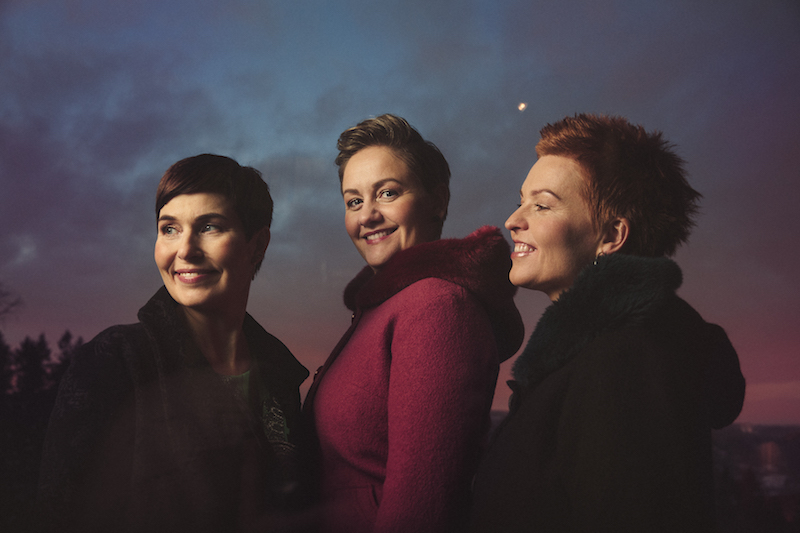Improvisation has long been a central part of Manfred Eicher’s celebrated artistic vision for his unique record label ECM which has focused on jazz and contemporary classical music. And one of his most successful releases lays in Officium, a pioneering disc which brought together early vocal polyphony from the Hilliard Ensemble with the improvisation of jazz saxophonist, Jan Garbarek. Here was a form of fusion that appealed very much to contemporary listening tastes around two decades ago, one which appealed equally to the new ager who sought something meditative, and jazz and early music fans alike. And it was this venture which no doubt inspired this collaboration between the Oslo-based Trio Mediaeval and trumpeter Arve Henriksen.
 Trio Mediaeval. Photo © Ingvil Skeie Ljones
Trio Mediaeval. Photo © Ingvil Skeie Ljones
Performed to a packed house at the Catholic cathedral, St Francis Xavier, this brilliant quartet presented their 2017 release, Rímur along with a few other selections. Like Garbarek, trumpeter Arve Henriksen has created a new sound world for his instrument, forsaking the more familiar burnished, ‘brassy’ tone for one which was much more gentle and flute or reed-like. The influence of Miles Davis’ muted tone on Sketches of Spain was also prominent, likewise evoking a vast and often monotonous vista with a minimal use of notes. Yet here Henriksen suggests the vast distances between land and the sea, time and space and even monody and early polyphony in the very old songs and melodies. As well as using a standard trumpet, he provided a variety of tone colour with the higher pitched piccolo trumpet as well as a wooden baroque style flute. Sympathetic sound design – aided here by Jim Atkins – meant that loops effectively provided drones and light percussion whilst never deterring from the reconstruction of these songs. Similarly vocalist Anna Maria Friman’s violin not only suggested that Norwegian folk instrument – the Hardanger fiddle (which was so appropriate for the latter Icelandic settings) but the eeriness of the hurdy-gurdy. It was little touches such as these that brought the early monody of these manuscript-based pieces so firmly to life.
The trio of vocalists preferred the clarity and direct engagement of the folksinger over the trained voice, and often in the earlier tunes, the songs’ components seemed to hold more than a semblance to well-crafted melodic pop, which the singers sang with an appropriate sense of ebullience and identification. Here was a quartet of vocalists who knew each other’s voice at an almost intuitive level – capable of exemplary clarity in three and four parts one minute, and next, to dissolve into one note of the finest purity. Similarly, advantage was taken of the church’s finest acoustics when the musicians split themselves into different areas, thereby aiding in precision and clarity at the same time.
The recorded release, Rímur, was performed in its entirety, however in a different running order and with a couple of equally fine colourations from the same manuscript sources. Similarly it must be noted that this tradition of music is very much an oral one. There is much here that also reminds us of the Eastern modal system and sounds almost gypsy-like at times, whilst improvisation (be it compositionally or in terms of performance) is forever present. The modern notation of these ancient tunes didn’t really commence until the 1960s and it’s an area where much work continues to be done. We cannot know exactly how the Vikings sang and composed, but this work goes a long way towards solving that riddle.











Comments
Log in to join the conversation.